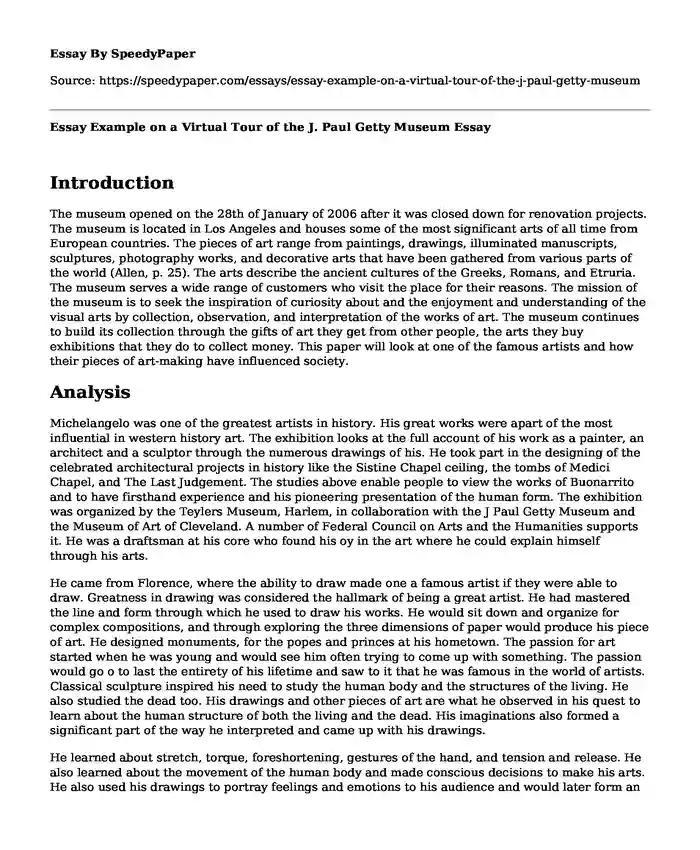Introduction
The museum opened on the 28th of January of 2006 after it was closed down for renovation projects. The museum is located in Los Angeles and houses some of the most significant arts of all time from European countries. The pieces of art range from paintings, drawings, illuminated manuscripts, sculptures, photography works, and decorative arts that have been gathered from various parts of the world (Allen, p. 25). The arts describe the ancient cultures of the Greeks, Romans, and Etruria. The museum serves a wide range of customers who visit the place for their reasons. The mission of the museum is to seek the inspiration of curiosity about and the enjoyment and understanding of the visual arts by collection, observation, and interpretation of the works of art. The museum continues to build its collection through the gifts of art they get from other people, the arts they buy exhibitions that they do to collect money. This paper will look at one of the famous artists and how their pieces of art-making have influenced society.
Analysis
Michelangelo was one of the greatest artists in history. His great works were apart of the most influential in western history art. The exhibition looks at the full account of his work as a painter, an architect and a sculptor through the numerous drawings of his. He took part in the designing of the celebrated architectural projects in history like the Sistine Chapel ceiling, the tombs of Medici Chapel, and The Last Judgement. The studies above enable people to view the works of Buonarrito and to have firsthand experience and his pioneering presentation of the human form. The exhibition was organized by the Teylers Museum, Harlem, in collaboration with the J Paul Getty Museum and the Museum of Art of Cleveland. A number of Federal Council on Arts and the Humanities supports it. He was a draftsman at his core who found his oy in the art where he could explain himself through his arts.
He came from Florence, where the ability to draw made one a famous artist if they were able to draw. Greatness in drawing was considered the hallmark of being a great artist. He had mastered the line and form through which he used to draw his works. He would sit down and organize for complex compositions, and through exploring the three dimensions of paper would produce his piece of art. He designed monuments, for the popes and princes at his hometown. The passion for art started when he was young and would see him often trying to come up with something. The passion would go o to last the entirety of his lifetime and saw to it that he was famous in the world of artists. Classical sculpture inspired his need to study the human body and the structures of the living. He also studied the dead too. His drawings and other pieces of art are what he observed in his quest to learn about the human structure of both the living and the dead. His imaginations also formed a significant part of the way he interpreted and came up with his drawings.
He learned about stretch, torque, foreshortening, gestures of the hand, and tension and release. He also learned about the movement of the human body and made conscious decisions to make his arts. He also used his drawings to portray feelings and emotions to his audience and would later form an essential role in his thinking process. The process revealed how he worked tirelessly to make the pieces of art that are present in the modern world. He, however, would destroy most of his drawings on his way towards growing into a legend of innate creative ideas. His creations showed a lot of effort behind them and the willingness of somebody better of with being a creative genius. Through his work, we see the struggles that he underwent that the geniuses behind is work.
Michelangelo never intended his work to be shown to the public. He was keeping his pieces of art well to avoid other people from seeing them. Among the drawings he had made, he was using them as working tools back at his home and did not want other artists to know his work and his ideas of how he used to develop his drawings. That is the reason he destroyed most of his drawings and would not want anyone to be associated with them. The exhibition played a significant role in helping identify who Michelangelo Buonarroti and his great works of art. Through the exhibitions, some people gathered some of the histories about the man and that behind the construction of the structures where popes and princes lived.
Works Cited
Allen, Susan M. "Toward an international art library: the growth of the Research Library at the Getty Research Institute, 1979-2002." Art Libraries Journal 27.4 (2002): 25-32.
Eknoyan, Garabed. "Michelangelo: art, anatomy, and the kidney." Kidney international 57.3 (2000): 1190-1201.
Cite this page
Essay Example on a Virtual Tour of the J. Paul Getty Museum. (2023, May 30). Retrieved from https://speedypaper.net/essays/essay-example-on-a-virtual-tour-of-the-j-paul-getty-museum
Request Removal
If you are the original author of this essay and no longer wish to have it published on the SpeedyPaper website, please click below to request its removal:
- Comparison Essay Example: Pollock and Rothko Art Designs
- Essay Sample on Description of the Artist
- Essay Sample on Musical Signs Analysis Using Piece's Semantic Tools
- Free Essay Example: First Nations Art
- Essay Sample on Essence of Music Therapy on Children With ADHD and ASD
- Free Essay Example. Overview of the Contract
- History of Guitars - Free Essay Example
Popular categories





